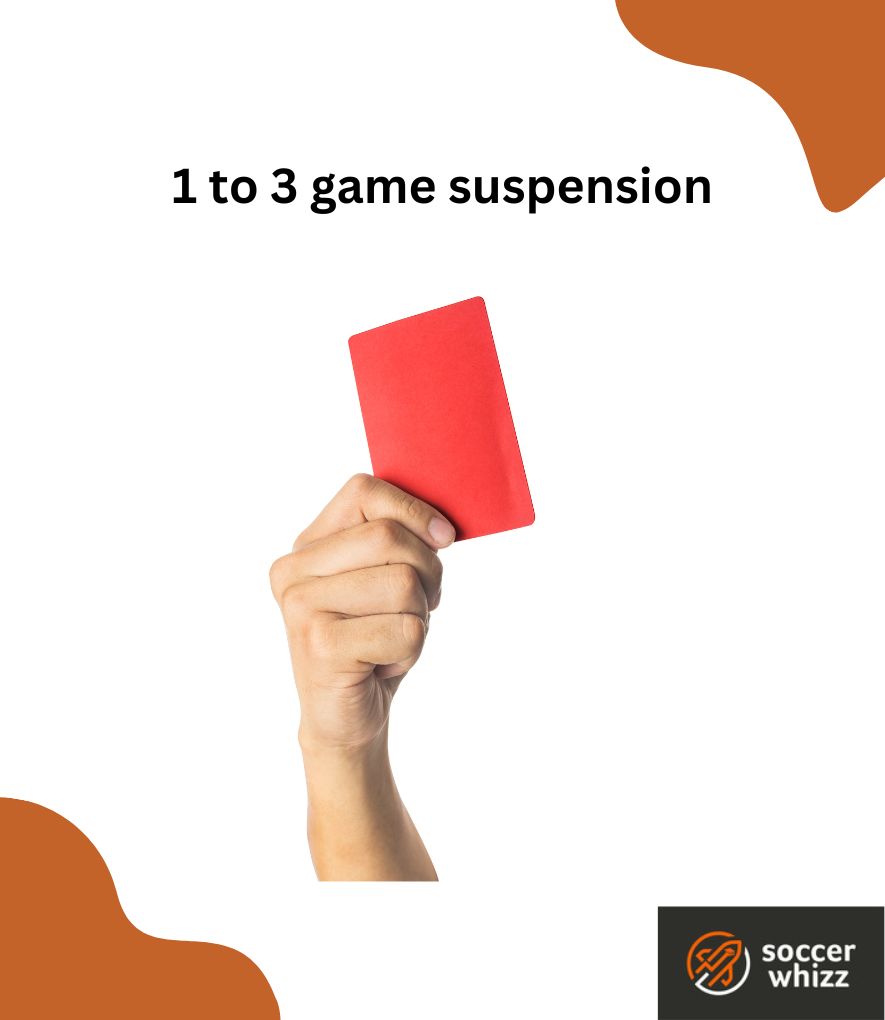In the realm of soccer, the red card holds a unique position of authority.
Its appearance in a referee’s hand invokes a whole range of emotions such as anger, despair and, sometimes, even relief!
The red card in soccer signifies the highest level of punishment, often leading to a player’s ejection from the game and significant consequences for both the individual and the team.
When a red card is issued by a referee, the player on the receiving end of the punishment must immediately leave the field of play, taking no further part in the match as well as not being able to be replaced by a substitute player, which forces the team to play with one fewer on the pitch.

This article aims to provide a comprehensive overview of what a red card represents in soccer.
We’ll delve into its origins, examine the circumstances that warrant a red card, explore the immediate consequences faced by the offending player and their team, and discuss the wider impact it can have on the course of a match.
- What happens if a red card is given to a player?
- Which actions can lead to red card punishments?
- How many soccer games does a player miss if they get a red card?
- Which players have received the most red cards in soccer history?
- How many players can be sent off in a single soccer game?
- Can a goalkeeper get a red card?
- Concluding thoughts on what a red card means in soccer
What happens if a red card is given to a player?
When a player receives a red card in soccer, they are immediately expelled from the field and are prohibited from participating in the remainder of the match.

Moreover, they face an ensuing suspension that starts from the subsequent game.
Unlike the yellow card which serves as an official caution, this disciplinary action removes the player from the current game and imposes further consequences that extend into future matches.
The red card is typically shown by the referee, who holds the authority to enforce the rules of the game and maintain fair play.
Once a player is shown a red card, they must leave the field of play immediately.
They cannot be replaced, meaning their team will be left with one fewer player for the remainder of the match.
Ultimately, the player is required to leave the vicinity of the field, and they usually head to the locker room or an allocated area for ejected players.
Which actions can lead to red card punishments?
A player can be issued a red card if they:
- Engage in serious foul play;
- Display violent conduct;
- Spit on another person;
- Deliberately handle the ball to prevent the opposing team from scoring a goal or an obvious goalscoring opportunity;
- Commit an offense, punishable by a free kick or penalty kick, that denies an opponent moving towards the player’s goal an obvious goalscoring opportunity;
- Use offensive, insulting, or abusive language and/or gestures; and
- Receive a second yellow card during the same match.
Reference – FA Laws of the Game on Fouls and Misconduct
How many soccer games does a player miss if they get a red card?
The rules regarding disciplinary actions vary across different competitions, but both yellow cards and red cards can lead to suspensions.
Generally, receiving a red card will result in an automatic suspension ranging from one to three games in the same competition, depending on the severity of the offense.

Additionally, accumulating multiple yellow cards throughout the season, acquired in different games, can also lead to a suspension, which varies based on the specific league or competition’s regulations.
Typically, if a player receives two yellow cards (equivalent to a red card) in the same competition, they will be suspended for the subsequent game.
However, it’s important to note that the suspension will only apply to the specific competition in which the offense occurred.
For instance, if a player receives a red card in a Premier League match but their next game is in the UEFA Champions League, their suspension will only affect their participation in the Premier League.
Incidents involving race-related offenses often result in longer bans, surpassing the typical three-game suspension.
On the other hand, spitting incidents carry an automatic six-match ban as a severe form of misconduct.
Which players have received the most red cards in soccer history?
While soccer has seen its fair share of players known for their aggressive style of play and frequent fouls, it’s important to note that the reputation of players can vary over time and across different eras.
Here are a few notable examples of players who have been considered notorious for committing “red-card type” fouls:
1. Gerardo Bedoya
With a staggering total of 46 red cards, the Colombian defensive midfielder stands out as one of the footballers with an extensive record of dismissals.

Remarkably, even in his senior coaching debut in March 2016, he was shown a red card and sent off after only 21 minutes.
2. Cyril Rool
The former French football midfielder was remembered for his aggressive playing style, blind tackles and being at the centre of brawls on the pitch.

He amassed 25 red cards in his professional playing career.
3. Sergio Ramos
Renowned for his tenacious style of play and indomitable spirit, the former Real Madrid defender has established himself as a prominent figure in the world of soccer.

Holding the record for the most red cards in La Liga history, with a remarkable tally of 21, he has showcased his relentless determination on the field.
Additionally, in the prestigious Champions League tournament, Ramos has earned four red cards, securing his position as the player with the highest number of cards and jointly the most red-carded player in the history of the competition.
How many players can be sent off in a single soccer game?
In a game of soccer, a maximum of four players from one team can be shown a red card during the course of the match.
If, by any chance, a fifth player from the same team is presented with a red card, the referee will promptly terminate the game.
Additionally, the team with five players shown red cards will be considered forfeit, resulting in a loss for that particular match.
It’s important to note that if a team is left with fewer than seven players (due to red cards, injuries, or other reasons), the game is usually abandoned as it becomes difficult to continue with such a significant numerical disadvantage.
Can a goalkeeper get a red card?
When a goalkeeper is shown a red card in soccer, the same consequence applies to them as it would to any other player on the field – they are dismissed from the game.
As a result, the team is left with 10 players and must utilize their substitute goalkeeper to replace the one who was dismissed, requiring a readjustment of their formation.
However, if the team has already made all three of their permitted substitutions before the goalkeeper’s dismissal, the manager is faced with a unique challenge.
They must choose one of the outfield players to step into the role of the makeshift goalkeeper, taking on the responsibilities of guarding the goal for the remainder of the match.
Ultimately, this unexpected adjustment can significantly impact the team’s overall strategy and dynamics on the field.
As a matter of fact, we even have an entire article on what happens if a soccer goalkeeper gets a red card which is dedicated to this very topic.
It goes through all the possible red card outcomes for a player in this position so it’s worth having a read to find out more.
Anyway, a real life example of a forced team reshuffle as a result of a goalkeeper red card happened when Manchester City’s right fullback Kyle Walker was forced to play in between the posts following Claudio Bravo’s red card.
Here’s some video footage showing how he performed:
Overall, you can see the Englishman gave a really good account of himself, especially because the position was not a familiar one.
Concluding thoughts on what a red card means in soccer
In conclusion, the red card in soccer holds immense significance as the ultimate disciplinary measure within the sport.
It serves as a powerful symbol of authority, capable of swiftly altering the course of a match and imposing severe consequences on both players and teams.
Understanding the circumstances that warrant a red card, the immediate ejection of a player, and the subsequent suspensions is essential for all soccer enthusiasts.
For further reading on red cards, you can check out one of our related posts concerning how many red cards Lionel Messi has obtained throughout the course of his career.
If you enjoy the content that I create and would like to buy me a coffee, then I’d really appreciate it!
Any money that I earn through this donation will be re-invested into more content for this website.
Additionally, by sending in a donation you’ll also receive a copy of my recently released 190+ page eBook on Soccer Ball Care, as well as be subscribed to our mailing list where you’ll be regularly informed on the latest developments concerning the Soccer Whizz blog.
- Future Icons: Europe’s Emerging Midfield Maestros Set for Glory - December 4, 2023
- Kickstarting a Revolution: How Soccer Transformed the United States Over the Last Four Years - October 7, 2023
- 4-1-4-1 Soccer Formation [Analysis] - September 23, 2023

